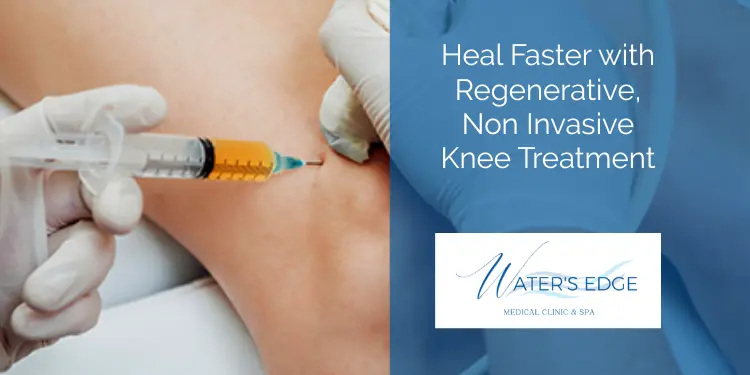Living with joint pain can really affect your day-to-day life. Simple things become difficult, and it’s easy to feel stuck. But there’s a new way to approach healing that uses your body’s own abilities. This is where joint regeneration therapy comes in, offering a different path for those looking to get back to moving without constant discomfort. We’ll explore what this treatment is all about and how it might help you.
Key Takeaways
- Joint regeneration therapy uses your body’s natural healing powers to fix damaged joints, often using things like stem cells or PRP.
- It’s an option for conditions like arthritis and sports injuries, aiming to restore function and reduce pain without surgery.
- Getting ready for the therapy and following up with physical therapy afterward are important steps for the best results.
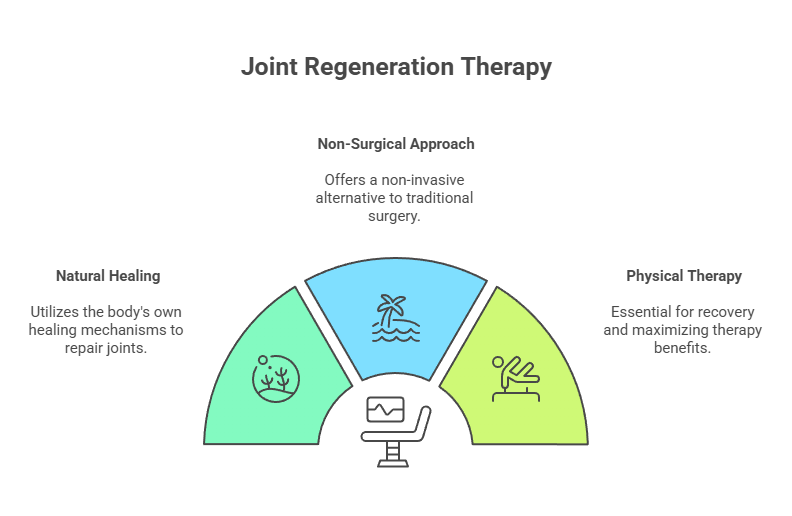
What Is Joint Regeneration Therapy and How Does It Work?
Joint regenerative medicine aims to restore and rebuild damaged tissues in the joints. Instead of just masking symptoms, it aims to get to the root of the problem. Think of it as helping your body heal itself, but with a little scientific boost. This approach is becoming more popular for treating various joint issues, especially for those experiencing regenerative medicine for joint pain.
The Core Idea
The main goal is to restore the joint’s natural function. This often involves using the body’s own healing components. The therapy typically uses cells or substances that can grow into new tissue or signal the body to repair itself. It’s a way to potentially reverse damage rather than just manage it.
How It Works: A Look Inside
While specific methods can vary, the general process involves a few key steps:
- Assessment: A doctor will first check your joint condition. This usually involves talking about your pain, looking at your medical history, and possibly using imaging like X-rays or MRIs.
- Cell Sourcing: Often, the therapy uses cells from your own body. These might come from bone marrow or fatty tissue. These cells are special because they can turn into different types of tissue, like cartilage.
- Preparation: Once collected, the cells undergo laboratory processing for further use. They are concentrated to make sure you get a good amount of the healing components. Sometimes, special fluids or growth factors are added to help the cells work better.
- Injection: The prepared cells or substances are then injected directly into the damaged joint. This is usually done with the help of imaging to make sure they go exactly where they’re needed.
What’s Being Used?
Several types of regenerative treatments are available. One common method involves using mesenchymal stem cells (MSCs). These cells are known for their ability to help repair tissues. Even the tiny particles released by these cells, called extracellular vesicles, can be used and have shown promise in treating conditions like osteoarthritis. Other treatments might use platelet-rich plasma (PRP), which comes from your own blood and contains growth factors that help healing.
It’s important to remember that this is a developing area of medicine. While many people find relief, results can differ from person to person. The focus is on natural healing processes, which can take time.
Conditions That Benefit from Joint Regeneration Therapy
Joint regeneration therapy is a promising approach for a variety of joint issues. It’s particularly helpful for conditions where the natural cushioning within the joint, like cartilage, has worn down. This commonly results in pain, joint stiffness, and reduced mobility. Many individuals experience relief from chronic joint pain, especially when other treatments have failed.
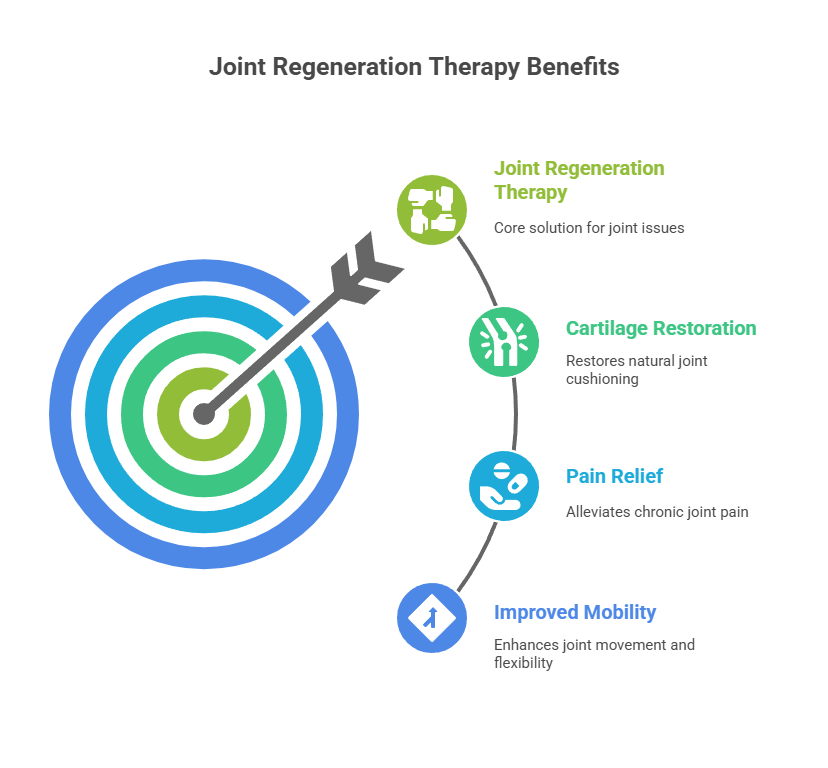
Osteoarthritis
It happens when the smooth cartilage in your joints starts to break down, making movement painful and stiff. It can affect almost any joint, but it’s most common in the knees, hips, hands, and spine. Common symptoms are pain, stiffness, and swelling in the affected joints. Regenerative medicine for knee arthritis, for example, aims to stimulate the body’s own repair mechanisms to rebuild damaged cartilage and reduce inflammation.
Rheumatoid Arthritis
While primarily an autoimmune disease, rheumatoid arthritis also causes joint inflammation and damage. Regenerative therapies can help manage the inflammation and potentially repair some of the tissue damage caused by the condition.
Sports Injuries
Acute injuries, like ligament tears or cartilage damage from sports, can lead to long-term joint problems if not treated effectively. Joint regeneration therapy promotes faster healing and improved joint function, helping athletes resume their activities sooner with a lower risk of re-injury.
Tendinitis and Bursitis
These conditions are caused by inflammation of the tendons or bursae—small fluid-filled sacs that help cushion your joints. While often treated with rest and anti-inflammatory medications, persistent cases can benefit from regenerative approaches that promote tissue healing.
It’s important to remember that while joint regeneration therapy offers a lot of hope, it’s not a magic bullet. The best results come when it’s combined with a healthy lifestyle and a commitment to rehabilitation. Think of it as a powerful tool in your overall joint health strategy.
Degenerative Joint Disease
This is a broader term that encompasses conditions like osteoarthritis, where the joints break down over time. It’s characterized by the gradual loss of joint function and increasing pain. Regenerative treatments focus on reversing or slowing this degeneration process.
Comparing Joint Regeneration Therapy to Traditional Treatments
When you’re dealing with joint pain, it’s natural to look at all the options. Traditional treatments have been around for a while, and they often focus on managing symptoms rather than fixing the root cause. Think about pain relievers, anti-inflammatory drugs, or even physical therapy. These can help, sure, but they don’t always get to the heart of the problem, especially if there’s actual tissue damage.
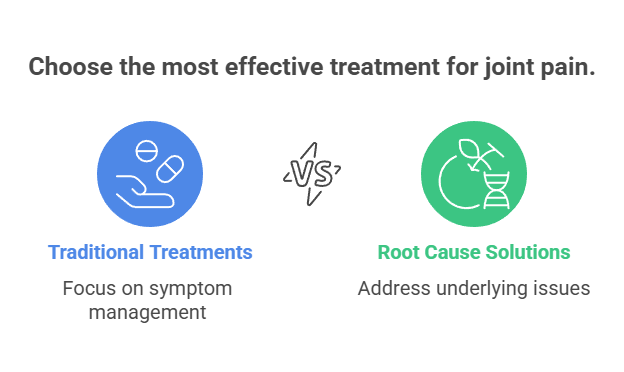
Pain Medications and Anti-inflammatories
These are common first steps. They can reduce swelling and numb pain, making it easier to move. However, they don’t repair damaged cartilage or ligaments. Long-term use can also come with its own set of issues, like stomach problems or other side effects. It’s like putting a bandage on a deeper wound – it helps for a bit, but the underlying issue remains.
Physical Therapy and Lifestyle Changes
Physical therapy is great for strengthening the muscles around a joint, which can offer support and improve function. Lifestyle changes, like weight management and low-impact exercises, also play a big role in reducing stress on joints. These are important parts of any joint health plan, but they might not be enough on their own for significant damage. They support healing but don’t directly initiate it.
Surgical Interventions
For severe cases, surgery like joint replacement might be suggested. This is a major procedure that replaces a damaged joint with an artificial one. It can offer significant relief, but it involves a long recovery, potential complications, and the artificial joint won’t last forever. It’s a more invasive approach compared to regenerative options.
Regenerative Therapies: A Different Approach
Regenerative therapies, on the other hand, aim to use your body’s own healing power to repair damaged tissues. Instead of just masking pain, treatments like PRP (platelet-rich plasma) or stem cell therapy work to rebuild cartilage and other joint structures. The objective is to bring back the joint’s normal function and overall health. This approach often means less downtime and a more natural healing process. It’s about getting your body to heal itself, rather than just managing the symptoms.
Many patients find that regenerative medicine offers a way to get back to activities they love, like hiking or playing with grandkids, without the long-term reliance on medication or the risks of major surgery. You can explore more about these treatments at regenerative therapies.
Comparing Treatment Outcomes
| Treatment Type | Primary Goal | Tissue Repair Potential | Recovery Time |
| Pain Medications | Symptom Management | Minimal | Immediate |
| Physical Therapy | Strength & Function | Supportive | Weeks to Months |
| Surgery (e.g., Replacement) | Joint Replacement | High (Artificial) | Months to a Year |
| Regenerative Therapy | Tissue Regeneration | High (Natural) | Weeks to Months |
Finding Regenerative Joint Therapy Near Me: What to Look For
When you’re looking for regenerative joint therapy near me, it’s important to know what makes a clinic or practitioner a good choice. This isn’t like picking a new coffee shop; it’s about your health and getting real results. You want someone who knows what they’re doing and uses the right methods. Think about it – you’re trying to heal your body naturally, so the provider should be focused on that goal too.
Qualifications and Experience
First off, check the credentials of the doctors or specialists. Are they board-certified in a relevant field, like regenerative medicine, orthopedics, or sports medicine? How long have they been actually performing these specific types of treatments? A provider with years of experience in regenerative therapies is more likely to have seen a variety of cases and know how to handle them. Don’t be shy about asking about their training and background.
Treatment Approaches and Technologies
Regenerative medicine is a growing field, and different clinics might use slightly different techniques or technologies. Some common approaches involve using your body’s own stem cells or platelet-rich plasma (PRP). It’s good to understand what methods they use and why they believe those methods are best for your specific condition. Ask them to explain the science behind their treatments in a way that makes sense to you. For example, understanding the process of how cells are extracted and prepared can be helpful.
Patient Testimonials and Success Stories
What are other patients saying? Look for reviews or testimonials that talk about actual outcomes, not just general satisfaction. Do people mention reduced pain, improved mobility, or a better quality of life? Real stories from people who had similar issues can give you a good idea of what to expect. It’s also helpful if they share details about their recovery process.
Personalized Treatment Plans
Your joint issue is unique, so your treatment plan should be too. A good clinic won’t offer a one-size-fits-all solution. They should review your medical history, perform a comprehensive exam, and talk with you about your individual goals. This leads to a plan tailored specifically for you, which often yields better results. They should also discuss potential risks and what a realistic recovery timeline looks like.
Cost and Insurance
It’s also practical to discuss the financial aspect. Regenerative treatments can sometimes be costly, and insurance coverage can vary. Ask for a clear breakdown of costs upfront and inquire about payment options or plans. Understanding what your insurance covers, if anything, is important for planning. You can find clinics that accept most insurances for certain types of pain treatments, though regenerative medicine itself might not always be covered Waters Edge Medical Clinic and SPA.
What to Expect During Your Visit
When you first visit a clinic, expect a detailed consultation. This usually involves:
- Reviewing your medical history and current symptoms.
- The doctor will check the joint to see how it’s working and what might be causing discomfort.
- Discussion of your treatment goals and expectations.
- Explanation of the proposed treatment plan, including the specific regenerative techniques to be used.
- Information on preparation for the procedure and post-treatment care.
It’s always a good idea to go into your first appointment with a list of questions. This ensures you get all the information you need to make an informed decision about your care. Don’t hesitate to ask for clarification on anything you don’t understand. Your comfort and confidence in the treatment are key.
What to Expect from Joint Regeneration Therapy Results
After undergoing joint regeneration therapy, patients often report noticeable improvements, though the timeline for these changes can vary. It’s important to remember that this is a natural healing process, and your body’s response will be unique. Many individuals find that pain begins to subside within the first few weeks, allowing for a gradual return to daily activities. You might also observe an increase in your joint’s flexibility and a reduction in stiffness.
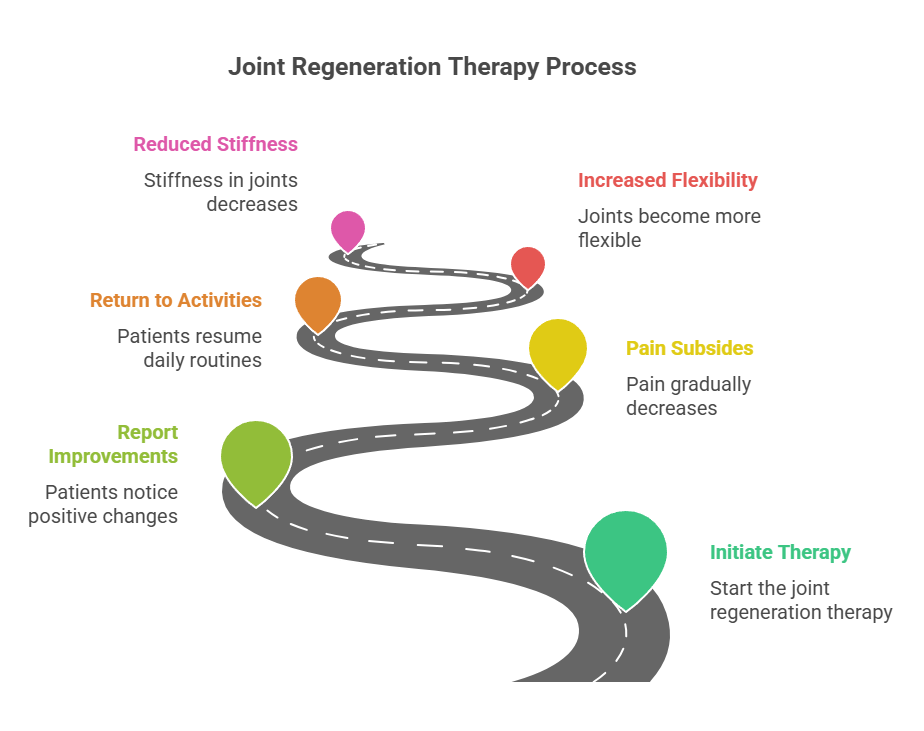
Initial Improvements and Timeline
- Pain Reduction: Many patients experience a decrease in pain levels relatively soon after treatment, often within weeks.
- Improved Mobility: You might begin to experience improved mobility and an expanded range of motion in the joint that was treated.
- Reduced Inflammation: Swelling and inflammation around the joint typically lessen as the healing process takes hold.
Long-Term Benefits and Recovery
Over several months, the effects of joint regeneration therapy can become more pronounced. We’re not just masking the pain—we’re helping your body heal the damaged tissue. This may result in significant, long-term enhancements in joint performance and daily living. A consistent rehabilitation program, including physical therapy, is key to maximizing these long-term gains. Think of it as a 12-week regenerative journey where progress is steady but requires your active participation.
Factors Influencing Outcomes
Multiple factors can impact the speed and success of your results. Factors include the nature of the condition, the extent of joint damage, your general health, and adherence to post-treatment guidelines. Taking care of your body through smart food choices and joint-safe habits can make a big difference in your healing journey. Be sure to inform your doctor about all medications and supplements you’re currently taking, as they may interfere with your healing.
Patience and consistent adherence to your personalized recovery plan are paramount. While some see rapid changes, others experience a slower, more gradual return to full function. Acknowledging small milestones during recovery can help keep you motivated over time.
Potential for Activity Restoration
Many patients who were previously limited by joint pain find they can return to activities they love. This could mean anything from walking longer distances to participating in sports or simply enjoying everyday tasks without discomfort. The aim of joint regeneration is to restore not just function but also your ability to live life more fully. If you’re looking for options in Florida, clinics like Waters Edge offer specialized care to help you achieve these outcomes.
Wondering about the results of joint regeneration therapy? While outcomes can differ for everyone, many people experience significant improvements in pain and movement. It’s a promising option for those looking to get back to their active lives. Ready to learn more about how it could help you? Visit our website today to discover the possibilities and book your consultation!
Looking Ahead: The Promise of Natural Joint Healing
So, we’ve talked a lot about how joint regeneration therapy works, using your body’s own power to fix things up. It’s pretty amazing, really. Instead of just masking pain or going for major surgery, this approach aims to get to the root of the problem and help your joints heal themselves.
Think about it – less downtime, fewer risks, and a more natural way to get back to doing the things you love. While it’s not a magic bullet, and everyone’s recovery is a bit different, the idea of helping your body do what it does best is a really hopeful one for anyone dealing with joint pain. It’s definitely worth looking into if you’re looking for a different path to better joint health.
Frequently Asked Questions

What is joint regeneration therapy?
Joint regeneration therapy uses your body’s own healing powers to fix damaged joints. It often involves using special cells, like stem cells or platelets from your blood, that can help rebuild worn-out or injured tissue. This can reduce pain and help you move better without surgery.
What kinds of joint problems can this therapy help with?
This therapy can help with many joint problems, such as arthritis, which is when the cushioning in your joints wears down. It can also help after sports injuries or if your joints have been damaged over time. The goal is to help your body repair itself and get your joints working well again.
What should I do after joint regeneration therapy?
After the therapy, you’ll likely work with a physical therapist to do exercises that strengthen the muscles around your joint. Eating right and staying at a healthy weight can really make a difference in how you feel and heal. It’s important to be patient, as healing takes time, and following the plan your doctor gives you is key to getting the best results.
If you have any additional questions or if you would like to see if regenerative medicine is right for you, please contact us at Waters Edge Medical Clinic 727-550-0855 and receive a free consultation and evaluation.

